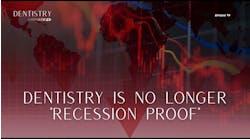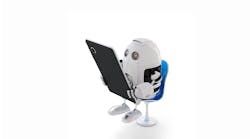The message of advertising has to appeal to a basic instinct.
Fred Joyal
Approximately 6,000 advertising messages bombard consumers each day. Every message offers an opportunity for consumers to spend their disposable income. Unless dentistry is one of those messages, it will never even be a consideration for many people.
Dentists are beginning to realize the value of advertising. However, a lingering mind-set that advertising is unprofessional or unethical has hindered the industry from fully exploring the possibilities. The success of the 1-800-DENTIST cooperative advertising program, and that of other major dental advertisers such as Western Dental and Castle Dental Centers, demonstrates the power of advertising. Promoting dentistry through television commercials has proven to be viable. Consumers are being educated and responding to the benefits of visiting the dentist. High quality commercials that inform the public about dentistry today and encourage regular dental visits have swayed some dentists away from their anti-advertising position.
Change is inevitable and necessary. Dentistry is becoming a sophisticated business. There now are numerous Wall Street-backed dental practice management firms. Between Wall Street and managed care, you can be sure that advertising will become an even greater force within the industry. Those interested in changing with the times can turn this into a wonderful opportunity.
So what`s next in dental marketing and advertising? Two marketing success stories serve as a lesson. First, there is the beef industry. As health and diet consciousness increased in this country, particularly in the 1980s, beef sales declined precipitously. The television advertising campaign that reversed that trend is a classic. Robert Mitchum`s husky voice came on over beautiful images and intoned, "Beef. It`s what`s for dinner." Some very sophisticated marketing was going on behind the scenes in this commercial. First, the images: bulls, cowboys on horseback, lassos. This is pure Americana - rugged individuals conquering the frontier. The final image, a perfectly broiled, still steaming, juicy steak, looked so succulent you could almost smell it, if not downright taste it. And Mitchum`s deep, manly voice - it didn`t hurt that he had a reputation for being rugged, even a rebel. The spoken message: beef (the product, simple and straight) is what America (reinforcing the imagery, playing on our strong patriotism) eats for dinner (notice the marketing here: lunch is a burger - go for the big-ticket item, steak or prime rib for dinner). It all came together to create a real desire in the viewer. They made you want it.
Next case: milk. The California Milk Processors Board also faced declining consumption of their product. Their "Got Milk?" campaign not only reversed that trend, but so successfully captured public attention that it has become part of the national lexicon. Clever scenarios are combined with fresh, in-your-face cinematography. It makes the viewer feel the sticky sensation of eating chocolate chip cookies or peanut butter and jelly sandwiches, then discovering an empty milk container. The simple slogan, intoned dramatically at the end, is the only audible message needed. It`s another case of great behind-the-scenes marketing. A situation to which almost anyone can relate. You always get to see the product, the empty milk carton, while feeling the pain of not having it - not an easy feat. The resonating slogan is something you can ask yourself anywhere: sitting on the couch, standing in the kitchen, or at the grocery store. It all comes together to create terrific desire. Not only does the viewer crave the sensation of wanting to wash something down with a cold glass of milk, he/she wants to make sure to never run out of the stuff. It is brilliant marketing and advertising.
Notice what they did not use in either case. No "packed with protein, fortified with minerals and iron," or "calcium enriched" messages. They have blown right by the "features" and are just ringing the "benefits" bell - it tastes good and makes one feel good too. It`s all about desire, not practicality.
In so doing, they have blurred the difference between types of advertising. Traditionally, advertising fell into two categories: image and direct response. Image advertising builds awareness in a product or brand. Direct response stimulates immediate demand or sales for a product. Both cases cited speak for themselves.
The marketing challenge facing dentistry today is how the dental community continues to build image while creating demand. How do we make people want dentistry? Advertising promoting the "features" of dental treatment (e.g., "preventive treatment can eliminate the need for corrective procedures" or periodontal disease has been linked to heart disease") has not created a strong desire to visit the dentist.
It would be a mistake to say those messages have failed completely. Sixty-nine percent of people in a national survey recently said they had visited a dentist in the past year. However, of those who did not, 44.6 percent cited a lack of perceived need as the reason.1 Dentistry has failed to create real demand - desire - for its services. The "health sell" doesn`t have sizzle!
It is not just dentistry that has missed the boat. Advertising spending by health-care providers has risen from just more than $200 million in 1990 to $800 million in 1996.2 Meanwhile, health-related expenditures have fallen as a percentage of our Gross National Product from 14.6 percent to 8.8 percent during that same period.3 It`s no surprise, considering these services are not as accessible, as simple to explain, or as tasty as beef or milk.
The Beef Council didn`t think they had anything terribly interesting either. If you look at its earlier marketing, it sounds like a bunch of old cattlemen promoting a few steakhouse with real Naugahyde booths. The Milk Processors Board had virtually no marketing aimed at adults prior to the "Got Milk?" campaign, focusing instead on the benefits of milk consumption for children.
Dentistry can offer two things proven by other industries to be highly desired by consumers. First, looking good. Products and services related to looking good - apparel, accessories, makeup, jewelry, hair care, plastic surgery - are in ever greater demand, fueled by desires to look more beautiful. Second, smelling good. Industries related to smelling good - fragrances, hair-care products, bathing products, deodorants, oral hygiene and breath products - also are thriving, again because of the desires of our society.
The next step in marketing and advertising dentistry is to create desire by focusing the message on looking good and smelling good. Is it appropriate for health-care professionals to deliver such a message? If the goal is for everyone to visit the dentist regularly, why not market a message designed to attract as many people as possible? Why not create a desire for a service that offers benefits as wonderful as dentistry does?
This strategy has already been employed, to some degree. More and more dental practices, particularly those trying to avoid the yoke of managed care, are promoting the cosmetic or esthetic aspects of their practice. Dr. Gordon Christensen asserts that bleaching makes an excellent introductory procedure that prompts many patients to continue with other esthetically oriented procedures.
Tooth-whitening has become one of the most requested esthetic procedures in dentistry. Named the hottest issue in cosmetic dentistry, it accounts for the majority of the more than 60 million cosmetic dental procedures performed in the United States every year.6 This is due primarily to the fact that manufacturers of bleaching products, both over-the-counter and those obtained through a dentist, are advertising at the consumer level, creating the desire for this procedure. The interest in bleaching creates a spill-over effect - the need created for tooth-whitening provides the opportunity for the dentist to diagnose needed treatment of which the patient would otherwise have been unaware.
When researching products, services or equipment for your practice, it`s a good idea to ask each company exactly what they are doing to market or advertise dentistry. Are they helping create demand? If not, why not?
So, how do we make people want dentistry? Create demand through desire. Create a lifestyle appeal - look good, smell good. Evaluate your own practice`s marketing and advertising. Are you doing as much as you can? Is it as good as it can be? Look at doing some marketing or advertising cooperatively. Often, more can be accomplished through collective efforts than individually.
Much like optometrists, dentists now face more challenges to independent practice. These obstacles can be overcome with proactive marketing and advertising. A great deal remains to be accomplished and many reward await those willing to make changes. Optometry engineered a change from "four eyes" to "fashion." Dentistry now has the opportunity to change from "tooth decay" to "a terrific smile."
References
1. Centers for Disease Control and Prevention survey report. MMWR, Dec. 19, 1997.
2. Peter Galuszka et al, See the doctor, get a toaster: intense rivalry has managed care plans tossing freebies, BusinessWeek Dec. 8, 1997.
3. United States 1996-97 Health and Injury Chartbook. Department of Health and Human Services, July 1997.
4. Christensen G., How the trend to elective dental procedures influences your practice. J. Am Dent Assoc., 129:355, March 1998.
5. U.S. Optical Industry Handbook 1995, Jobson Publishing Corp., 1995.
6. Burhahl B., Bleaching business is booming. AGD Impact, April 1998.
Fred Joyal is the chief executive officer of Futuredontics, Inc., which operates the 1-800-DENTIST referral service. He co-founded Futuredontics in 1986.
It`s how you look
Optometry is one health-related service that has done an excellent job of creating demand through a desire to look good. In this county, wearing eyeglasses has gone from a need to a want during the last 20 years. Like many dentists, optometrists were little prepared to implement marketing and advertising strategies into their practices to ensure successful transition into the future of eye care. As part of a highly technical industry that examines vision, these doctors were suddenly thrown for a loop when managed-care programs infiltrated their practices.
For many, finding a niche has meant creating a boutique atmosphere in their offices. Those who carry and dispense only the generic brands covered by insurance companies are essentially surrendering any power they may have over the future of their practices. Eyewear is so closely associated with its dispenser that these doctors risk sending the message to consumers that their practices are of inferior quality.
In 1995, a study revealed eye doctors as the top dispensers in eyewear with a 62.5 percent share of the industry`s $13.6 billion in sales.5 This study urged more doctors to wise up and take control of the industry that is rightfully theirs, by virtue of their expertise and experience. Today, eyeglass frames are likely to carry a designer label. Those who deal in eyewear, including doctors, are quite pleased with the savvy marketing that has reinvented the vision-care industry. Like the apparel and fragrances designer brands are associated with, advertisers and marketers have given eyewear the same "lifestyle" appeal. Eyewear has been successfully positioned as an essential part of the whole ensemble that characterizes a brand or quality-conscious person. Eyewear enhances their looks and reflects their personality rather than being merely a necessity that pinches their wallet or initiates hassles with their insurance plan.
Interestingly, the manufacturers underwrite a tremendous amount of eyewear marketing and advertising. They build image and brand awareness, typically in a designer label, but also create demand at the consumer level for their products and the optometrists` services. Some of this is beginning to happen in dentistry as well.





